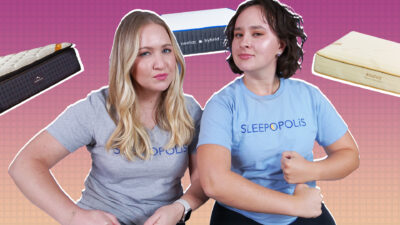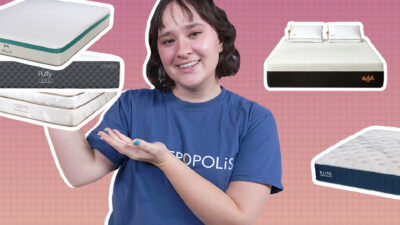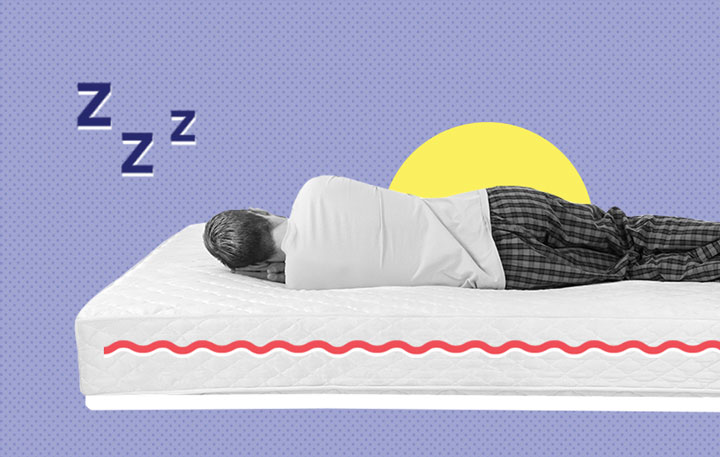
Firmness can be a tricky topic to discuss. Why? Well, everyone experiences the firmness of a mattress slightly differently. As with any feel factor, it’s subjective, and your personal preference can change a lot depending on your size, shape, and body weight. But, thankfully, there are a few benchmarks and standards you can use to better understand how to find the right mattress firmness for you.
To help you learn a little bit more about firmness and figure out what firmness you need, we’ve put together this mattress firmness guide. In it, we’ll go over what firmness is, how it’s measured by the mattress industry, and how to choose the firmness level that’s right for your unique sleeping needs. We’ll also discuss the difference between firmness and support, two terms that are often mistaken for one another.
With all that in mind, let’s kick things off by talking about what exactly firmness is!
What is Mattress Firmness?
The firmness of a mattress refers to the initial feel you experience when lying on it. Are you sinking into the mattress, or resting right on top of it? Are you experiencing a lot of push back, or do you notice that the materials are contouring to the curves of your body? These are just a few of the questions you can ask to determine whether or not a mattress is soft, medium-firm, or firm.
To help consumers understand firmness, the mattress industry will often score its beds on a “firmness scale” with a range from 1 to 10. A mattress that scores a 1 out of 10 would be the softest mattress in the world (picture sleeping on a giant cotton ball), and one that scores a 10 out of 10 would be the firmest (picture sleeping on concrete). For reference, a score of 6.5 out of 10 is widely regarded as the industry standard for medium firmness. I’ll describe the firmness scale in more detail below.
But for now, let’s go over what soft, medium-firm, and firm mattresses actually feel like.
Soft
Soft mattresses generally fall within the 3 to 6 (out of 10) range on the firmness scale. They typically utilize cushioning materials like quilted pillow tops or thick sections of memory foam in their top layers, also referred to as “comfort” layers. They’re characterized by feelings of deep sinkage, body contouring, and pressure relief.
You won’t experience too much pushback on a soft mattress, which means you’re likely to feel more “in” it than “on top” of it. Softer mattresses are generally preferred by strict side sleepers or those in need of a little extra comfort at the shoulders, hips, and lower back. Some popular examples of soft mattresses include the Layla, Helix Sunset, and Nectar mattresses.
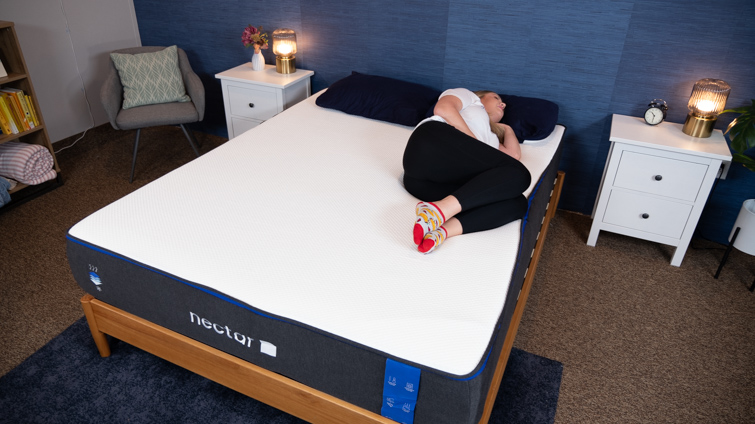
For more soft options, check out our guide to the best soft mattresses.
Medium-Firm
Medium-firm mattresses generally fall right at 6.5 out of 10 on the firmness scale. These beds usually combine soft foam top layers with sturdier foundations of either high-density poly foam or pocketed coils. This establishes a balance between pressure relief and support, which is appealing to a wide range of sleepers. However, some mattresses can be in the ballpark of medium-firm but feel a touch softer or firmer than average, such as a medium-soft 6 out of 10.
While you may experience some sinkage on a medium-firm mattress, you’re more likely to feel lifted up and out of the bed. For that reason, medium-firm mattresses can be great for combination sleepers or back sleepers, as these groups can benefit a lot from a little extra mobility. Some of our favorite medium-firm mattresses include the DreamCloud Premier Rest, Saatva, and Leesa Hybrid mattresses.
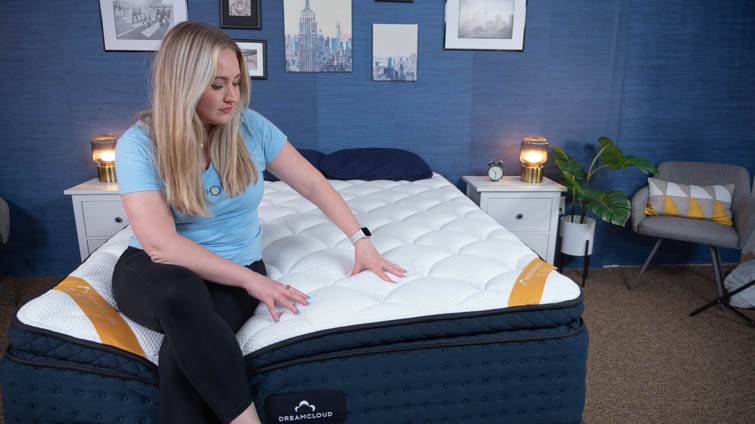
Firm
And finally, firm mattresses, which usually are a 7 out of 10 or higher on the firmness scale. These beds rarely employ soft or plush materials in their comfort layers; instead, they insert a thin layer of soft foam atop high-density poly foam or springs. Therefore, firm mattresses can be highly supportive.
On a firm mattress, every part of your body should be lifted squarely on top of the bed with plenty of pushback. Strict stomach sleepers and heavy people may appreciate the extra heft that they get from these structures. A few fantastic firm mattresses on the market are the Helix Dawn, Brooklyn Plank, and WinkBed mattresses. You can also check out our best mattress for heavy people roundup for more options.
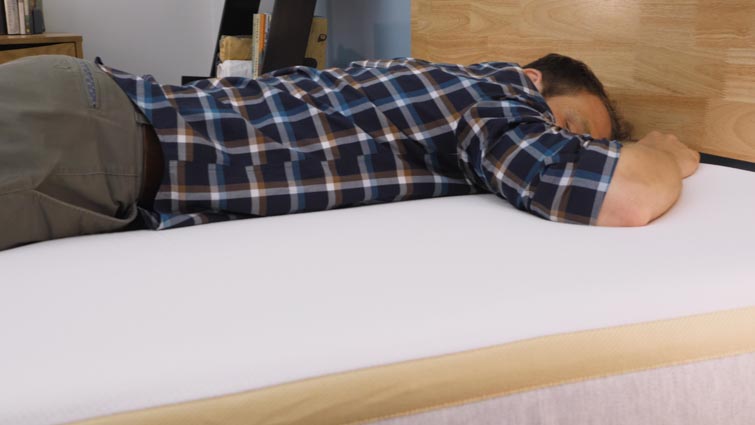
For more firm options, check out our guides to the best firm mattresses and best extra-firm mattress.
Understanding the Firmness Scale
So, now that we know what the three major firmness groups are, let’s revisit the entire firmness scale. This will give you a better idea of what a 3 out of 10 or a 7.5 out of 10 actually feels like when you’re doing your mattress research.
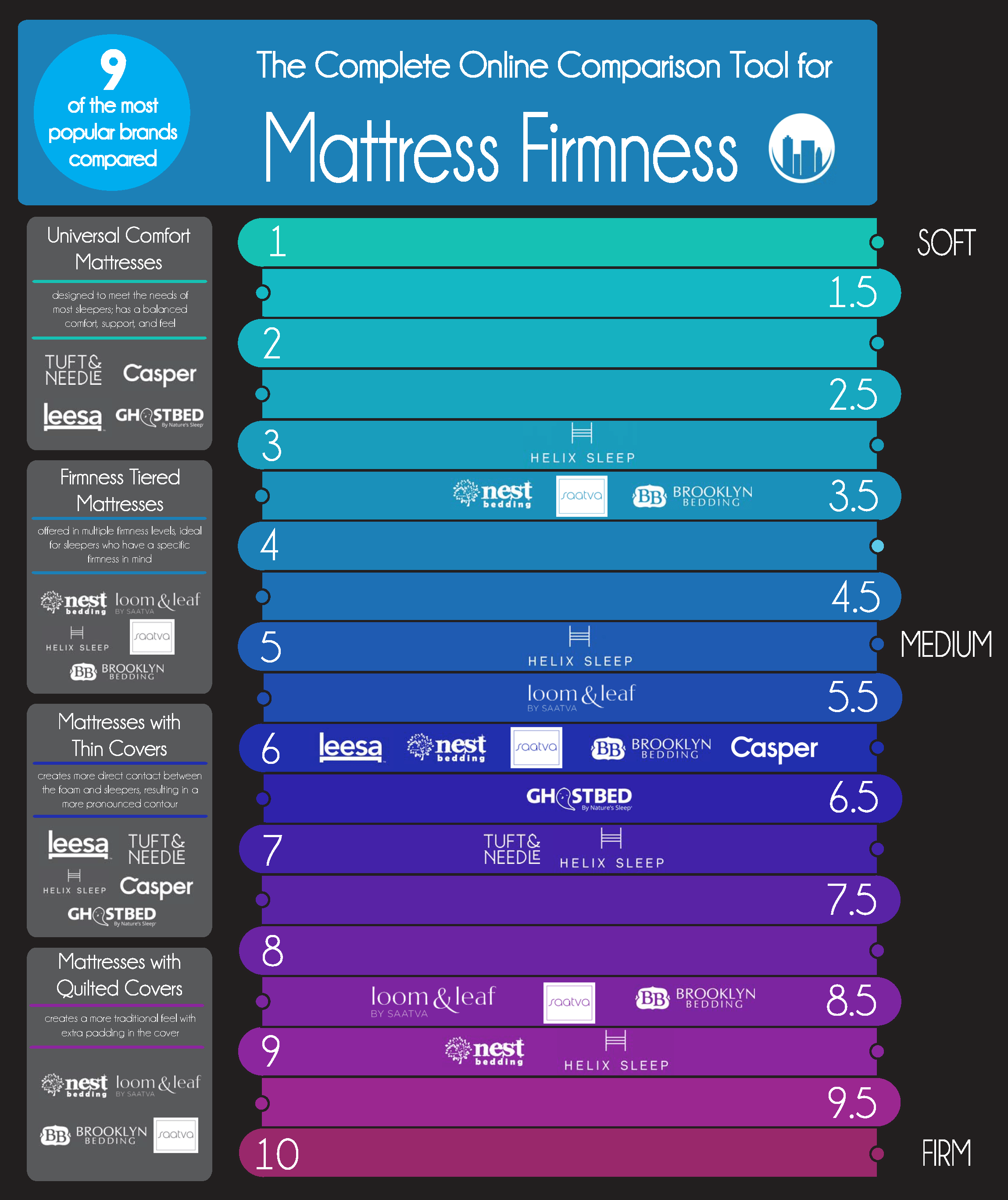
As I mentioned up top, these interpretations are subjective, but I think they offer some good insight into how these numbers translate into a real-life, on-the-bed situation.
- 1 out of 10, or extremely soft: It’s rare that you’ll find a mattress that’s a true 1 out of 10 on the firmness scale, because it would be, well… unsleepable. This kind of bed would offer way too much sinkage, disrupting any potential for support. Sleepopolis has never reviewed a mattress that would be considered a 1 out of 10.
- 2 out of 10, or ultra-soft: Slightly more realistic than a 1 out of 10 mattress, a bed that scored a 2 on the firmness scale still probably wouldn’t be supportive enough for the average sleeper. Again, this kind of structure would provide too much sinkage for most individuals. Sleepopolis has never reviewed a mattress that came in at a 2 on the firmness scale either.
- 3 out of 10, or very soft: 3 out of 10 on the firmness scale is a little more manageable, but it’s still rare to come across. While there’s still a lot of sinkage here, mattresses at this level start to provide a little more support. If a mattress scores a 3 out of 10, it’s usually built of memory foam, a gentle material known for deep pressure relief. This softness level is best for side sleepers.
- 4 to 5 out of 10, or soft: If we give a mattress a 4 to 5, we usually mean that it’s soft, but has a more balanced feel. Here, the comfort layers start to get a little thinner and most sleepers will feel a little less of that “stuck-in-the-bed” sensation that comes with softer mattresses. This firmness level is also best for strict side sleepers.
- 6 out of 10, or medium-soft: This is a more common score for a majority of bed-in-a-box mattresses that describe themselves as “soft.” You’ll still find plush comfort layers on a mattress like this, but they’ll be balanced out by a sturdy base of either high-density poly foam, coils, or springs.
- 6.5 out of 10, or medium-firm: It’s very common to come across mattresses that are a 6.5 out of 10 on the firmness scale. Although most mattresses on the market today land in the 6 to 7 firmness range and could be considered in the ballpark of medium-firm, a 6.5 is a true medium-firm bed. This means they strike a balance between pressure relief and support. Great for a wide range of sleepers, these beds can either be made entirely out of foam or out of a combination of foam and coils.
- 7 out of 10, or slightly firm: A score of 7 brings us into firmer territory. These beds are notable for how they lift the sleeper up and out of the structure. Combo sleepers, back sleepers, and stomach sleepers typically benefit from the extra lift of these mattresses.
- 8 out of 10, or firm: If we give a mattress an 8 out of 10 on the firmness scale, we’re saying that it’s very firm. You won’t feel a lot of body contouring or “hug” on these firmer mattresses, instead you’ll get a lot of pushback. These beds are great for back and stomach sleepers, and could also work for folks who prefer a more traditional feel.
- 9 out of 10, or very firm: A 9 out of 10 will feel similar to an 8 out of 10, but with even less hug and sinkage. There’s extreme pushback here, so most sleepers will likely find this kind of mattress a bit too firm for their needs. But heavier sleepers may prefer the extra-firm feel of an 8 out 10 mattress.
- 10 out of 10, or ultra-firm: And finally, a 10 out of 10. You’re not likely to ever encounter one of these puppies in the wild, but if you do, you should note that they won’t provide any pressure relief at all. Sleepopolis has never reviewed a true 10 out of 10 mattress.
What is the Best Firmness for a Mattress?
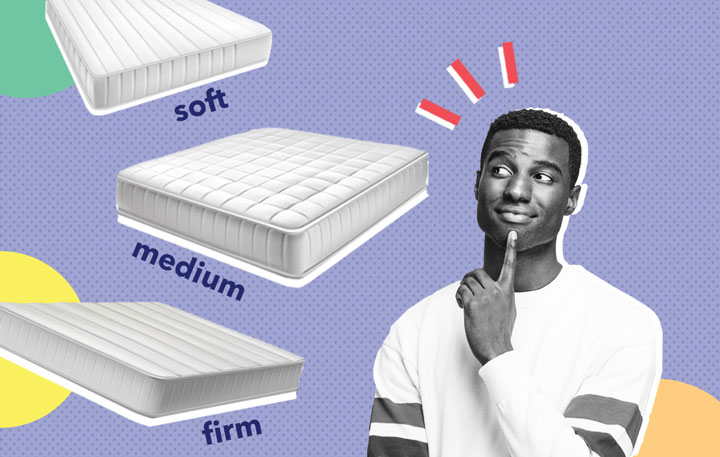
With this understanding of firmness in place, it’s time to riddle that age old question: What is the best firmness for a mattress? As you probably gathered, there is no one answer for this all-important Q. Why? Well, because firmness is such a personal thing. An ultra-firm mattress might be excellent for a stomach sleeper, but absolutely horrible for a side sleeper.
To help you better contextualize this question in terms of your own sleeping needs, let’s break down firmness by position.
Back Sleepers
Back sleepers are an interesting group, because they fall right between side sleepers and stomach sleepers in terms of their needs. They’re the easiest to please, but if their mattress is too firm, back sleepers may experience unnecessary tension and pinching at the lower back. If it’s too soft, their hips may dip out of alignment with their shoulders. For that reason, we usually recommend that back sleepers stick with a medium-firm mattress.
Why is this firmness level so good for back sleepers? Well, it helps to lift their spines into a neutral alignment, thereby establishing sound support and comfort across the back. This helps to alleviate pressure and pain, especially for those who struggle with things like fibromyalgia and arthritis.
As we touched on above, the industry standard for medium firmness is 6.5 out of 10, so a score around that number should work for these dreamers.
Back sleepers can find medium-firm comfort on a variety of different mattress types, but we’d suggest they start their search with hybrid mattresses. To be classified as a hybrid, a bed must utilize both foam and coil layers, which create a nice interplay between bounce and sink.
For more, check out my best mattress for back sleepers guide.
Side Sleepers
Side sleepers are a little less universally pleased than back sleepers. This group needs a soft mattress that provides plenty of room to sink in for deep and cuddly pressure relief at the shoulders, hips, and lower back. A mattress that offers zoned support might be a good fit for these sleepers. Mattresses offering zoned support are softer at the shoulders to allow some pressure relief, but firmer at the hips to offer extra lower back support.
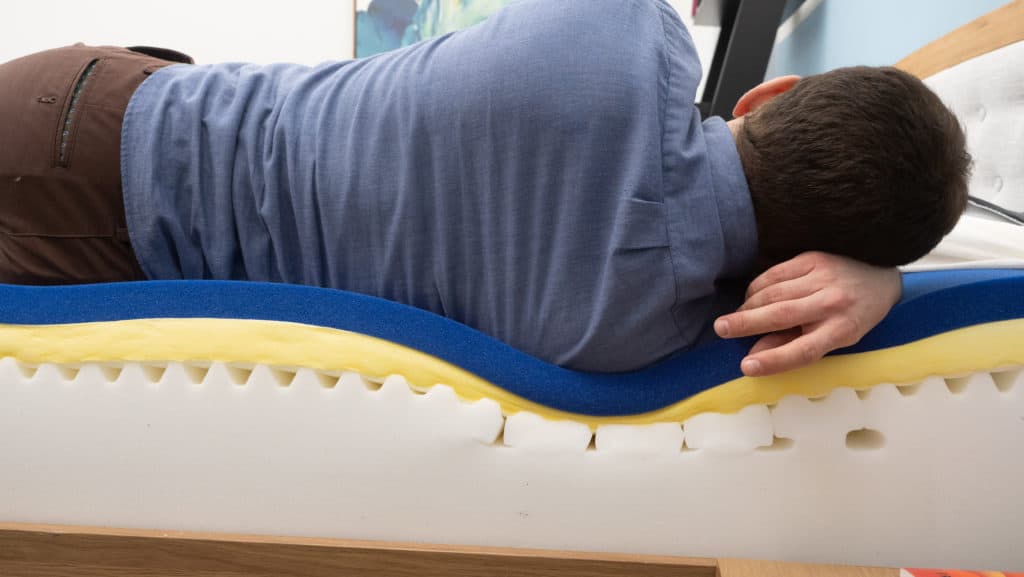
When we think about the softness level that’s most appropriate for side sleepers, we tend to focus on the 4 to 6 (out of 10) range.
Though side sleepers, of course, still need sound support, they also need to be greeted by thick layers of soft foam as soon as they hop into bed. This will help to cushion their joints as they press into the structure, ensuring that there won’t be any uncomfortable jamming or tension on their pressure points throughout the night. We recommend that side sleepers stick with memory foam mattresses or mattresses that contain cushy top foam layers, which are known for deep body contouring, sinkage, and pressure relief.
Get into our favorite side sleeper beds on our best mattress for side sleepers page.
Stomach Sleepers
We consider stomach sleepers the opposite of side sleepers because they need firm beds with plenty of lift and support. To avoid uncomfortable bowing at the lower back, these sleepers need to ensure that their hips are level with their shoulders, establishing a neutral spinal alignment. This is especially important for avoiding back pain. For that reason, we tend to steer stomach sleepers toward beds in the 7 and higher on the 1 to 10 firmness scale.
But just like side sleepers still need support, stomach sleepers still need comfort. The key is finding a mattress that brings together super supportive interior layers with cozy top sections for a bit of initial pressure relief. Stomach sleepers will likely do best on an innerspring or hybrid mattress built with a thin pillow top layer.
Need some stomach sleeping inspiration? Let us suggest our guide to the best mattress for stomach sleepers.
Is Firmness the Same as Support?
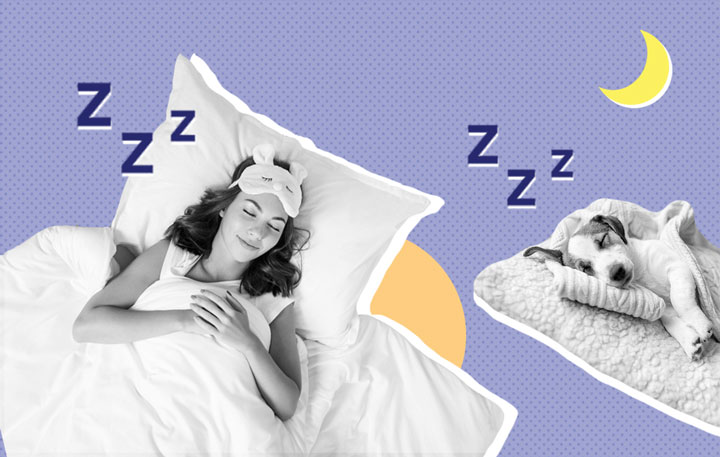
When thinking about firmness and support, many folks incorrectly assume that the terms are synonymous with one another. In fact, they refer to two totally different things. Firmness is all about the immediate feel you experience when first lying down on a mattress. Support, on the other hand, refers to how well the mattress keeps your spine in alignment. Therefore, you can find a soft mattress with a ton of support and a firm mattress with virtually no support at all.
It can be tricky to navigate this line between firmness and support, but it’s important to separate them in your mind when shopping for a new mattress. Remember: Firmness is simply how the mattress feels. Does it relieve pressure? Does it feel comfortable to you? Is there a lot of cushioning, a lot of pushback, or something in between? Learn more about what the most comfortable mattresses are for several sleeping styles
Support is about whether or not the mattress sets your spine in a neutral alignment. When you’re lying in your preferred sleeping position, do you feel like the mattress is doing a good or bad job of lifting your spine in a straight line all the way from your shoulders to your hips?
By focusing on each of these factors individually, you’ll be able to find a mattress that provides the support you need in your sleep position and is the right firmness level for you. Make sure to take a peek at our how to choose a mattress guide for more tips.
How to Choose Your Mattress Firmness
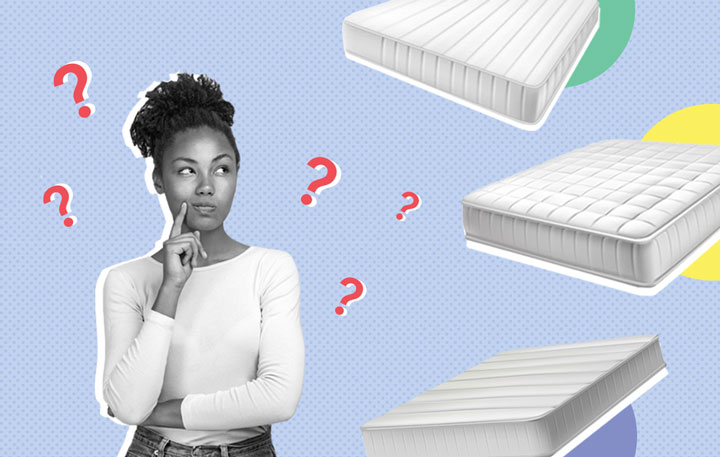
Now that you’re equipped with all the know-how you could ever want on different firmness levels, let’s apply it to a real world buying experience. Below, we’re going to run through some of the tips and tricks we use to pair folks with their ideal firmness level.
- What position do you sleep in? Above all else, this is probably the most important question to answer when considering firmness. Strict side sleepers will typically want something within the 3 to 6 range, while back sleepers will generally want to go with something in the 5 to 7 range. And, of course, anything above a 7 out of 10 should provide adequate support to stomach sleepers.
- How much do you weigh? Weight can also be a major factor. Heavier individuals will generally want a thicker mattress that provides plenty of foam layers to press into for deep compression support. Innerspring mattresses may also provide more durability to these sleepers. Heavier folks may experience mattresses as softer than those of more average weight, so if an average weight reviewer gives a mattress a firmness rating of 7 out of 10, these folks might experience it closer to a 6 out of 10.
- What’s your body type? Thinking about your specific body type will also help determine the firmness level you need. If you have a heavier midsection, you’ll want a firm mattress with a zoned support core to keep your spinal alignment neutral. If you’re a lighter weight sleeper, you’ll interact mostly with the top layers of your mattress, so may prefer a softer mattress that provides plenty of comfort.
- Remember: Firmness isn’t Support. Don’t forget that support and firmness are not the same. You can find a mattress with great support that’s still soft and meets all of your pressure relief needs.
- Still stumped? Go with the majority. If you still have no idea what firmness you should go with after reading through this guide, we recommend choosing a medium-firm mattress. A bed that hovers around the industry standard medium-firmness rating of 6.5 out of 10 can often provide universal comfort for most sleepers.
- Be careful with soft mattresses. Oftentimes, sleepers see the word “soft” and naturally gravitate towards it. This makes sense — softness seems to indicate coziness or luxurious plushness. However, soft mattresses can often become quite uncomfortable because they don’t provide adequate support for many sleeping positions. In fact, “soft mattresses” are among some of the most returned mattress types in the industry. So, if you want to go soft, please make sure that your bed has a solid core of either high-density poly foam or pocketed coils. This will also increase the lifespan of your mattress!
Final Word
Well folks, that about does it for our mattress firmness guide. When thinking about how firm you want your mattress to be, remember to focus on your sleeping position, how much you weigh, how much sinkage or hug you want, and what kind of support you need. That way, you’ll be set to find the firmness level of your dreams!


